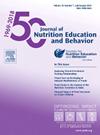大学生对美国南部一所公立大学免费烹饪和营养教育试点课程的接受程度
IF 2.3
3区 医学
Q2 EDUCATION, SCIENTIFIC DISCIPLINES
引用次数: 0
摘要
食品和营养不安全是美国大学生日益关注的问题。为了解决这个问题,我们开设了一个烹饪和营养教育课程,其中包括一个农产品项目,让学生有机会把同样的食材带回家做饭。目的评价大学生对农产品烹饪与营养教育试点课程的接受程度。研究设计、设置、参与者2024年美国一所公立大学的大学生被邀请参加四场30分钟的现场烹饪示范和营养教育课程中的至少一场,并获得10磅的农产品、烹饪工具和食谱磁铁。学生们完成了一项调查,评估班级的可接受性以及食物、营养和住房的不安全感。可测量的结果/分析使用李克特量表和开放式问题来测量具有生产程序的班级的可接受性。我们还评估了描述性特征和食物、营养和住房不安全的比率。结果总体而言,学生年龄为23±4.9岁,女性占88%,黑人或非裔美国人占55%,本科生占90%,食物无保障者占46%,营养无保障者占34%,住房无保障者占36% (n=130)。12%的学生参加了所有课程,25%参加了三节课,26%参加了两节课,36%参加了一节课。带农产品节目的烹饪课很受欢迎;超过90%的人表示他们会向同龄人推荐这个项目。食谱/烹饪示范是可以接受的;超过90%的人说他们很优秀,并帮助他们学习如何做一道菜。约91%的受访者表示,他们有信心在家尝试这一食谱,并计划购买特色水果和蔬菜。学生们开放式的回答反映了班级的可接受性;“我真的很喜欢他们使用我们会收到的容易获得的食材!太酷了!,“它是如何迎合学生的需求的,考虑到时间和金钱有限,而且宿舍可以使用”,以及“我希望每学期都开设这门课”。结论我们发现,在大学生中,包括那些食物和营养不安全的学生,对烹饪和营养教育试点课程有很高的接受度。FundingNone本文章由计算机程序翻译,如有差异,请以英文原文为准。
College Students’ Acceptability of a Free Pilot Cooking and Nutrition Education Class with a Produce Program at a Public University in Southern U.S
Background
Food and nutrition insecurity are emerging concerns among U.S. college students. To address this, we developed a cooking and nutrition education class with a produce program that offers students the opportunity to take home the same ingredients to cook.
Objective
Assess college students’ acceptability of a pilot cooking and nutrition education class with produce program.
Study Design, Settings, Participants
College students at a public U.S. university in 2024 were invited to attend at least one of four live 30-minute cooking demonstrations and nutrition education classes and receive ten pounds of produce, cooking tools, and recipe magnets. Students completed a survey that assessed class acceptability and food, nutrition and housing insecurity.
Measurable Outcome/Analysis
Acceptability of the class with produce program was measured using Likert scale and open-ended questions. We also assessed descriptive characteristics and the rates of food, nutrition, and housing insecurity.
Results
Overall, students were 23 ± 4.9 years, 88% female, 55% Black or African American, 90% undergraduates, 46% were food insecure, 34% were nutrition insecure, and 36% were housing insecure (n=130). Twelve percent students attended all classes, 25% attended 3 classes, 26% attended 2 classes and 36% attended one class. The cooking class with produce program was much liked; over 90% reported they would recommend this program to peers. The recipe/cooking demonstrations were acceptable; over 90% reported they were excellent and helped them learn how to make a dish. Around 91% reported they were confident to try the recipe at home and planned to buy the featured fruit and vegetables. Students open-ended responses echoed class acceptability; “I really liked that they used easily available ingredients we would receive! So cool!”, “How it’s (recipe) catered to students, they factored in limited time and money and is dorm accessible”, and “I hope this class is offered every semester”.
Conclusions
We found high acceptability of a pilot cooking and nutrition education class with produce program among college students, including those experiencing food and nutrition insecurity.
Funding
None
求助全文
通过发布文献求助,成功后即可免费获取论文全文。
去求助
来源期刊
CiteScore
4.20
自引率
11.50%
发文量
379
审稿时长
44 days
期刊介绍:
The Journal of Nutrition Education and Behavior (JNEB), the official journal of the Society for Nutrition Education and Behavior, is a refereed, scientific periodical that serves as a global resource for all professionals with an interest in nutrition education; nutrition and physical activity behavior theories and intervention outcomes; complementary and alternative medicine related to nutrition behaviors; food environment; food, nutrition, and physical activity communication strategies including technology; nutrition-related economics; food safety education; and scholarship of learning related to these areas.
The purpose of JNEB is to document and disseminate original research and emerging issues and practices relevant to these areas worldwide. The Journal of Nutrition Education and Behavior welcomes evidence-based manuscripts that provide new insights and useful findings related to nutrition education research, practice and policy. The content areas of JNEB reflect the diverse interests in nutrition and physical activity related to public health, nutritional sciences, education, behavioral economics, family and consumer sciences, and eHealth, including the interests of community-based nutrition-practitioners. As the Society''s official journal, JNEB also includes policy statements, issue perspectives, position papers, and member communications.

 求助内容:
求助内容: 应助结果提醒方式:
应助结果提醒方式:


